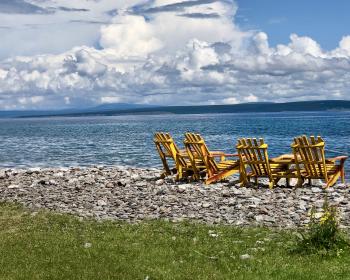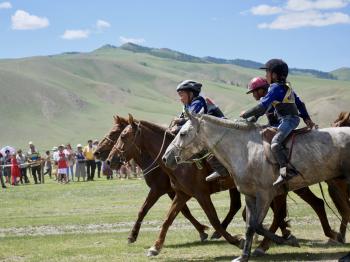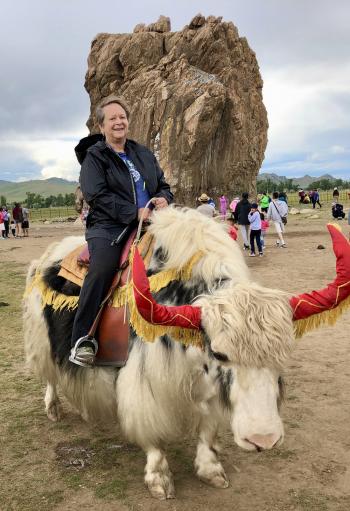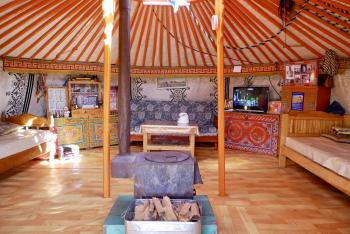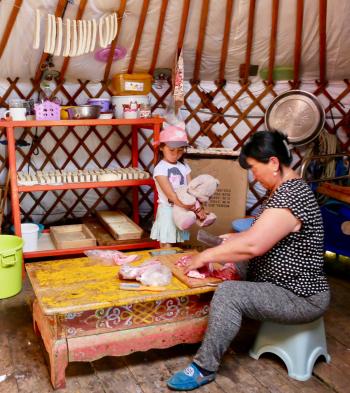Enchanted by nomadic life and the Naadam Festival on a guided tour of Mongolia
This article appears on page 6 of the March 2020 issue.
My interest in visiting Mongolia was first sparked by the charming documentary “The Eagle Huntress” and, more recently, by some alluring tour brochures. I had hoped to attend the fall Eagle Hunter Festival, but it didn’t fit into my schedule. However, my research told me that the annual Naadam Festival (in early July 2019) would, so I had a focus.
Making plans
On TripAdvisor.com, I found a recommendation for Discover Mongolia, in Ulaanbaatar, and on its detailed and attractive website (www.discovermongolia.mn) were many appealing trip options. The company representative responded promptly and helpfully to all my inquiries.
In addition to the fact that this company had many enthusiastic reviews posted on TripAdvisor, several other factors also influenced my decision to book with them. The cost of $3,601 (even with a single supplement, an extra hotel night at the beginning and end, and provisions for gers (yurts) with attached bathrooms when possible) was very reasonable for their 16-day “Discover Mongolia Tour & Local Naadam Festival.” And I liked the idea of supporting the country’s economy by using a local company.
I chose this particular tour because it covered different geographic areas in the country, involved numerous visits with nomad families, included attendance at the Naadam Festival out in the countryside and offered reasonable hikes in beautiful spots, encounters with various animals and a meaningful introduction to a country I knew little about. All that greatly appealed to this 71-year-old adventuress!
The website said that the usual tour group consisted of between 4 and 14 people. When my group converged in Ulaanbaatar, there was a woman from New Zealand, a man from Romania and me, plus our guide and driver. Needless to say, we were all delighted, and our small group size allowed flexibility and easy harmony as we traveled together.
In the course of our trip, we covered approximately 2,000 kilometers of Mongolia in our comfortable, well-equipped, off-road Mitsubishi van, which our driver kept scrupulously clean.
Ulaanbaatar
I must admit that my mental concept of Mongolia was kind of stuck in the 13th century with the mighty conqueror Genghis Khan. So before my trip, I did some reading to fill in the gaps.
As I traveled through Mongolia, one of the aspects that fascinated me was the way the country proudly integrates its past and its present, through dress, tradition, food, lodging and way of life.
We spent the first day of our tour in Ulaanbaatar with our guide, Marla, visiting the Gandan Monastery, which gave us an introduction to Buddhism (the central religion of Mongolia); the National Museum of Mongolia, which gave us a framework of history and culture for our trip, and the Zaisan Memorial, which is situated high above Ulaanbaatar.
From that vantage point, we could see traditional white gers dotted amongst all the modern architecture and new buildings rising in all directions.
That was also where I had my first unexpected and joyful moment in Mongolia. After paying a very small fee ($3), I held a 15-pound eagle on my arm for a couple of minutes!
Getting around
The next day we were up early for our flight to Dalanzadgad, located in the Gobi Desert. We were met there by guide Oyunaa and driver Nyama, and we began our adventure.
Over the course of the next two weeks, we would travel from the south to the north, crossing five of Mongolia’s 21 provinces, moving from the desert through the steppes to the forests.
Here is where I need to let you in on an important factor of Mongolian travel: the majority of roadways are unpaved. So all our driving, sometimes five hours a day, was done “off road,” which is to say, up and over ravines and hills on dry, gravelly or rocky ground or through scrub brush.
Yes, you get bounced around significantly, and, yes, you do need to do your business behind the van at times, but overall it is an awesome experience!
Herds of Bactrian camels (the 2-humped kind) and yaks and goats and cows wandered around us or across the road in front of us. We saw and waved to young and old herdsmen guiding their flocks, sometimes on horseback but often on motorcycles. When the van would stop, two or three nomad children would magically appear, setting up a small table or a blanket on the ground, enticing us to buy small camels or other handicrafts they’d made out of felt.
There are other trips, with Discover Mongolia and other companies, where there isn’t as much driving — you fly in and out of Ulaanbaatar every few days to different locations — but I really loved the drives and seeing the country unfold before me.
I was also continually astonished by the skill of our driver. With no GPS, no major landmarks and often no horizon, Nyama was adept at orienting himself to this unique landscape and getting us where we needed to go.
Into the desert
The Gobi Desert wasn’t like any desert I’d ever seen. There was not a grain of sand in sight until we reached the sand dunes in the northern Gobi. Instead, it was mostly hard-packed dry dirt with stones and rocks and scrub brush, sometimes flat and sometimes hilly. The landscape was constantly changing.
On our gradual trip north, we hiked into Eagle Valley, a verdant canyon surrounded by sheer rocky walls, and saw an ibex high above us on one of those rocks. The opportunity to view petroglyphs from the Bronze Age took us on a hike up a small mountain.
At sunset on another day, we walked among the Flaming Cliffs and envisioned the dinosaurs that roamed in these red sandstone canyons. (In the 1920s, this was where dinosaur eggs were first discovered.) We rode camels, horses and yaks, shed our shoes to climb glorious sand dunes, visited monasteries and museums, swam in a beautiful lake, hiked to the top of a dormant volcano, marveled at the carvings on deer stones dating back to the Bronze Age and enjoyed watching the landscape gradually change from desert to forest.
I remarked earlier about the blend of traditional and modern; this was strikingly displayed as we drove mile after mile through wide, open country, periodically sighting a small cluster of gers with some animals nearby out in the middle of an empty vista — and almost every ger we saw had solar panels and a satellite dish for TV reception! During our visits with nomadic families, we learned that they kept in touch with each other with cell phones.
For lodging, we stayed almost every night in what was called a tourist ger camp, which usually consisted of several dozen gers plus a separate building housing toilets and showers and another for meals. The food was generous and tasty, including some traditional dishes (meat at every meal — meat dumplings, beef, mutton soup and mutton stew) and others that were more familiar (eggs, soup, stew and bread).
Because of the long winters, not much grows in Mongolia. Most vegetables and fruit are imported from China.
The gers and the facilities were always clean, bright and attractive. Only once did we arrive late in the afternoon at a camp that didn’t quite look up to the high standards of the others, and our guide, Oyunaa, immediately got on the phone to the office. The manager started making calls, and by the time we finished dinner, they had made arrangements for us to go directly to a beautiful camp that had just opened four months earlier.
I very much appreciated the dedication and attention that both our guide and the company’s head office paid to fixing the problem immediately.
There were a couple of times we spent two nights in one location, but usually we changed every night. There was no Wi-Fi reception, but we usually could recharge our electronics from 7 to 10 p.m. either in our gers or in the main dining room.
Oyunaa was a delightful guide — knowledgeable, flexible, full of humor and good sense — a warm and gracious ambassador for her country.
Naadam Festival
One of the highlights of the trip was spending two days enjoying the annual Naadam Festival near Khar khorin, in the middle of the country. The festival is centered around what Mongolians call the “three manly sports”: wrestling, horseracing and archery.
The biggest Naadam celebration is in Ulaanbaatar, replete with much pageantry, costumes and an official welcome, and the events take place within a large stadium that seats thousands.
There are small Naadam festivals taking place simultaneously all over the country, in nearly every village and town, and everyone in the community attends.
I chose a trip that would take me to a regional celebration rather than the big-city event in the hopes of getting closer to the festivities, and that’s exactly what happened. We were within several yards of the horses, the archers and the wrestlers. Being so close, we really felt part of the action.
It felt very much like being at a colorful, vibrant county fair, where you could walk from event to event; sit when you felt like it; eat cheese-curd snacks and drink fermented mare’s milk from a communal cup if you were feeling brave; get in close for photos; see folks of all ages interacting and having fun, and feel the excitement and strong sense of community and tradition.
Surprise visit
One of the appeals of this trip, and my greatest delight, was the opportunity to visit with nomadic families. As part of our scheduled tour, we met with a camel herder and his family, with a family who welcomed us to a traditional Mongolian barbecue and with a reindeer-herding family in the north.
The nomads’ gers were brightly decorated, efficient and extremely well organized — essential, since they pack everything up and move several times a year, following the seasons and grazing possibilities for their animals. We were always welcomed with milk tea, cheese or dried curd snacks and the traditional greeting ritual that involved the passing of the host’s treasured snuff bottle to each guest.
Through Oyunaa’s interpretation, we learned about their daily chores and pace of life. They introduced us to their grandchildren, and I showed them photos of mine.
The barbecue we attended was intriguing. Meat was alternately layered with hot stones, potatoes and carrots, the whole thing tightly sealed with a heavy rock and left to cook for 45 minutes.
The most meaningful visit for me was a spontaneous one. One evening, after a planned visit, I expressed to Oyunaa my hope that we could meet more nomadic families. The next morning, she announced that we would drive for an hour or so and see if we could find some nomads to visit!
We set off, coming eventually to a cluster of three gers, and pulled the car in close. Oyunaa got out, introduced herself and us and asked if we might visit. Without a moment’s hesitation and with great pleasure, the shepherd and his family immediately invited us into their immaculate and beautifully decorated ger.
The mom invited us to sit and partake of milk tea, cheese, bread and dried yogurt snacks, and the dad offered each of us in turn the chance to open and smell his ornamental snuff box.
This family had a flock of horses and of goats, and they invited us to see what this part of their day was like. From a few feet away, we witnessed them milking the mares; this needed to be done every two hours during the day! Then we saw the goats being shorn; their hair becomes the treasured Mongolian cashmere.
The couple’s children frolicked among the foals and the goats and showed us the presses used to make the dried yogurt snacks. The parents told Oyunaa that we were the very first foreigners they had ever met.
It was an extraordinary experience of a life so different than ours, yet we were all able to share and laugh and feel connected. This was the legendary hospitality of the Mongolian nomads.
By the end of this unique and wonderful adventure, I had ridden on a horse, a camel and a yak, been kissed by a baby reindeer, held an eagle on my arm, explored a unique and beautiful country with knowledgeable, engaging and delightful guides, challenged myself with some amazing hikes and made some wonderful new friends. What more could one ask for?


